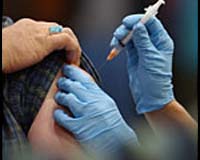| . |  |
. |
Montreal (AFP) July 27, 2009 Canada's native communities already hard hit by the swine flu pandemic could witness a devastating spike in the number of cases during the region's long winter months ahead, health experts warn. Heavily affected by historic outbreaks, notably the 1918 Spanish flu, Canada's 1.2-million-strong Inuit and Aboriginal communities have been disproportionately hit by the A(H1N1) virus. And the infection rate comes despite their isolation, with the native people's living primarily in remote communities in the forested center and the Arctic north of the country. More than 10,000 people in Canada have contracted the A(H1N1) virus so far, including more than 55 people who have died. But while the swine flu infection rate in the general population has seen a ratio of 24 per 100,000, Manitoba tribes in central Canada have seen rates of 130 per 100,000, according to the current affairs magazine Macleans. Inuit communities in the far north Nunavut territory meanwhile have seen an outbreak on an even larger scale, with an infection ratio at a massive 1,070 per 100,000. "We are not clear at this point how much of that relates to underlying risk factors like obesity, smoking, diabetes, chronic lung disease," David Butler-Jones, Canada's Chief Public Health Officer, told AFP. Also, it is not clear to authorities "whether there is in fact a genetic component of risk to this," Butler-Jones added. Historians have highlighted the disproportionate toll wreaked by the Spanish flu of 1918-1919 on the same populace. For example, in the village of Cris in the remote north-central Norway House indigenous community in Manitoba, 183 members -- some 20 percent of the population -- died over a six-week period. The same devastation was seen in Saint Theresa Point, with a population of 3,200, just east of Norway House. Already fearful for the indigenous communities as the swine flu crisis began to take hold in almost every nation, Canadian authorities sent emergency health technicians out in June to help them battle the virus. In all, 500 people were seen to be exhibiting influenza symptoms and a hundred others were evacuated by helicopter. "The working hypothesis now is that this pandemic will follow the 1918 (pattern)," said Ethan Rubinstein, professor of infectious diseases at University of Manitoba, noting however that medical advances since that time could still lessen the final toll. "I don't expect the death rate to be even close to 1918, but the spread of the disease may still be like that," he said. The leading representative for Canada's native communities, Assembly of First Nations (AFN), has slammed Ottawa for what it says has been inadequate efforts to help the region. The "measures aimed at containing the virus were ill-suited to the social realities of First Nations," said the AFN. Examples of unhelpful advice, said the organization, include communities being told "to avoid contact with others, while living in cramped and overcrowded conditions, or being told to wash their hands frequently, when running water was not available." AFN Regional Chief Angus Toulouse, who holds the health portfolio at the organization, told a recent government hearing that "clearly, if there is no improvement in planning and services, the worsening of this virus could have tragic consequences" in the coming months. The chief medical officer of health for the Nunavut, Isaac Sobol, went further to slam authorities over what he suggested was the inevitable result of neglect. "Successive Canadian governments have not wanted to highlight the situation concerning Inuit and Aboriginal health. We see the results now," Sobol said. The AFN called this month for native communities to receive priority vaccination against swine flu, in light of its disproportionate impact. Canadian Health Minister Leona Aglukkaq said earlier this month that distribution would be ordered by risk. "Those most at risk will receive the vaccine first. We expect that the H1N1 vaccine will be made available by late October, early November, and everyone who needs (the) vaccine will be able to get at least one dose before Christmas," Aglukkaq said. Share This Article With Planet Earth
Related Links Epidemics on Earth - Bird Flu, HIV/AIDS, Ebola
 Rich countries corner supplies of swine flu vaccine
Rich countries corner supplies of swine flu vaccineParis (AFP) July 27, 2009 Governments are scrambling to buy up hundreds of millions of doses of swine flu vaccine but health experts warn the poor may lose out as wealthy countries corner strictly limited supplies. The World Health Organisation has unofficially estimated that the world's labs may only be able to produce around 900 million doses for the A(H1N1) strain per year, for a planet that is home to 6.8 billion ... read more |
|
| The content herein, unless otherwise known to be public domain, are Copyright 1995-2009 - SpaceDaily. AFP and UPI Wire Stories are copyright Agence France-Presse and United Press International. ESA Portal Reports are copyright European Space Agency. All NASA sourced material is public domain. Additional copyrights may apply in whole or part to other bona fide parties. Advertising does not imply endorsement,agreement or approval of any opinions, statements or information provided by SpaceDaily on any Web page published or hosted by SpaceDaily. Privacy Statement |